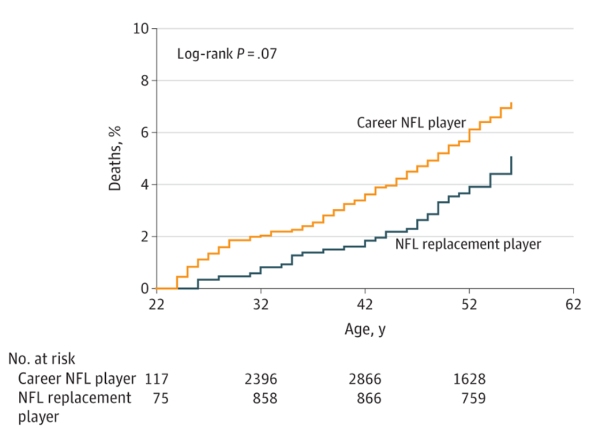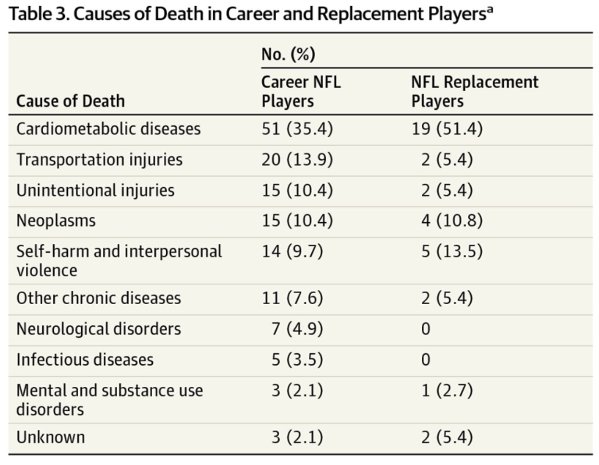Blog Post
The Long-term Mortality Risk of Playing in the NFL
Compared to 1987 "replacement players"

Maheer Gandhavadi (Everett Clinic), Anupam B. Jena (Harvard University), and I have new study in JAMA today on the long-run health consequences of playing professional football.
Here’s the premise: there have been concerns about the long-term health of retired National Football League (NFL) players. But evaluating these long-run consequences is challenging, because professional football players tend to be at the extremes of physical fitness. Finding an appropriate comparison group to such a highly select population is hard. Prior studies have used age and race-matched men from the general population, and they find that NFL players live a lot longer. This is not surprising because NFL players are much healthier/physically robust than regular men. They have to be in order to make it in the league.
Our insight was that we needed to find a better control group. So we reached back into NFL history and found the “replacement players” – generally men with some prior football experience (college, semi-pro, sometimes other pro leagues) who played during the three weeks of the NFL player strike in 1987. We thought they’d be more similar to NFL players in terms of training, fitness, football experience, without significant exposure to the game. This might make them an ideal control group. So we compared the long-term mortality risk of 2,933 career NFL players and the 879 replacement players. Here is what we found:

Basically, career NFL players had a higher hazard of mortality (by about 38%) compared to replacement players, but because so few people died – our cohorts were so young – we could not rule out a null difference (or a large difference).
We also looked at causes of death. Because only 4.2% of replacement players and 4.9% of NFL players died, we didn’t have a lot of deaths to look at, so again we can’t make strong claims here. Nevertheless, the patterns are of interest. Among NFL players, the proportion of deaths from cardiovascular disease was lower, while the proportions from traffic accidents and overdoses were higher. We also found seven deaths from Amyotrophic Lateral Sclerosis (ALS) among NFL players – and none among replacement players.

What should you take away from this? While the findings are not definitive, the results stand counter to previous work looking at mortality among NFL players. We think our findings should definitely motivate future work that follows these groups over time, as statistical power will only increase. The comparisons can be made sharper, too. In the future, a better matched comparison may exclude NFL players who have really long careers, as selection on the basis of health is likely correlated with player tenure.
Mainly, we think our method could be a useful roadmap for people interested in the causal consequences of participating in the NFL on health. The natural experiment approach may be useful in understand the health consequences of exposure to football at other levels, as well. Our approach can only speak to differences in health from partaking in the sport professionally. But one could coming up with natural experiments to differentiate exposure to football and other sports at various levels – Pop Warner, high school, college – all of which help us better understand how to make sports safer.
For more on NFL player health, check out the JAMA podcast, which covers this and other papers, and our Op-Ed in Stat News.